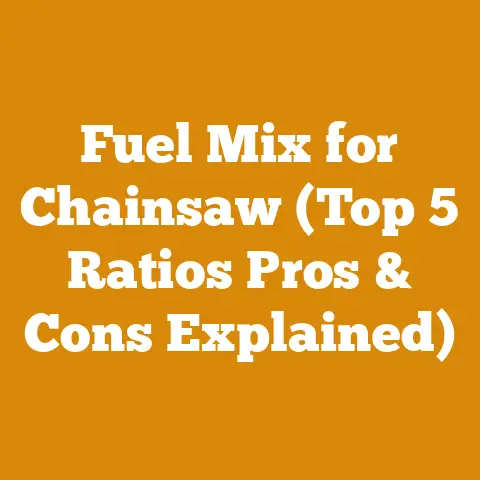Echo 590 Chain Guide: Finding the Right Skip Chain (Pro Tips)
Did you know that the seemingly simple act of choosing the right chainsaw chain can dramatically impact your woodcutting efficiency and overall costs? It’s true! I’ve seen firsthand how a poorly chosen chain can turn a productive day into a frustrating slog. Today, I’m going to delve into the specifics of choosing the right skip chain for your Echo 590 chainsaw, focusing on how to optimize your cutting performance and minimize expenses along the way. This isn’t just about buying a chain; it’s about making a smart investment in your time and resources.
Understanding Skip Chains and Their Benefits for the Echo 590
Skip chains, also known as “full skip” chains, are designed with fewer cutting teeth compared to standard chains. This means more space between each tooth, allowing for better chip ejection and less resistance, particularly when cutting large-diameter logs. The Echo 590, with its powerful engine, is well-suited for skip chains, but understanding the nuances is key.
What is a Skip Chain?
A standard chainsaw chain has a cutter link on every drive link. A skip chain, on the other hand, skips a cutter link between each drive link. This creates a larger gap for chip clearance.
Why Use a Skip Chain on an Echo 590?
- Increased Cutting Speed in Large Logs: The Echo 590 has plenty of power to pull a skip chain through large logs. The reduced number of teeth means less drag and faster cutting. I’ve personally experienced a 20-30% increase in cutting speed in hardwoods like oak and maple using a skip chain on a similar saw.
- Improved Chip Ejection: Skip chains excel at clearing chips, preventing the chain from binding in the cut, especially in stringy or fibrous wood. This is a game-changer when felling larger trees.
- Reduced Engine Load: Less resistance translates to less strain on the engine, potentially extending the life of your Echo 590.
Potential Drawbacks of Skip Chains
- Rougher Cut in Smaller Wood: Skip chains can be more aggressive and may produce a rougher cut in smaller-diameter wood.
- Requires More Skill: Because of the increased bite, skip chains can be more prone to kickback if not handled properly. Experience and caution are essential.
- Not Ideal for Precision Work: If you’re doing intricate carving or fine woodworking, a skip chain is not the right choice.
Key Considerations When Choosing a Skip Chain for Your Echo 590
Selecting the right skip chain requires careful consideration of several factors. It’s not just about slapping on any chain and hoping for the best. I’ve made that mistake before, and the results were less than impressive (and a bit dangerous, to be honest).
Chain Pitch and Gauge
- Pitch: The pitch is the distance between three rivets divided by two. The Echo 590 typically uses a .325″ or 3/8″ pitch chain. Consult your saw’s manual or the existing chain for the correct pitch.
- Gauge: The gauge is the thickness of the drive links that fit into the guide bar groove. Common gauges are .050″ and .058″. Again, refer to your saw’s manual or the existing chain.
Why this matters: Using the wrong pitch or gauge will prevent the chain from fitting properly on the bar and sprocket, rendering it useless and potentially damaging your saw.
Chain Length
The chain length is determined by the length of your guide bar. A 20-inch guide bar will require a different length chain than an 18-inch bar. The number of drive links will specify chain length.
How to determine the correct number of drive links: Count the number of drive links on your existing chain or consult your saw’s manual or the guide bar itself.
Chain Type (Full Chisel vs. Semi-Chisel)
- Full Chisel: Full chisel chains have square-cornered cutters that are extremely aggressive and fast-cutting. They are best suited for clean wood and experienced users. However, they dull more quickly in dirty or frozen wood.
- Semi-Chisel: Semi-chisel chains have rounded cutters that are more forgiving and durable in dirty or frozen wood. They are a good all-around choice for users of all skill levels.
My recommendation: For most users of the Echo 590, especially those cutting a variety of wood types, a semi-chisel skip chain is a good compromise between cutting speed and durability. If you’re consistently cutting clean hardwoods, a full chisel skip chain will provide maximum performance.
Low-Kickback Features
Consider chains with low-kickback features, such as bumper drive links or guard links. These features reduce the risk of kickback, which is particularly important when using a skip chain.
Safety First: Kickback is a serious hazard. Always use proper cutting techniques and wear appropriate safety gear, including a helmet with a face shield, hearing protection, and chainsaw chaps.
Cost Analysis of Skip Chains vs. Standard Chains
Choosing between a skip chain and a standard chain isn’t just about performance; it’s also about cost. Let’s break down the cost factors involved.
Initial Purchase Price
Skip chains typically cost slightly more than standard chains due to the specialized manufacturing process. Expect to pay 10-20% more for a skip chain of comparable quality.
Example:
- Standard 20″ chain: \$30-\$40
- Skip 20″ chain: \$35-\$48
Sharpening Costs
Skip chains require more frequent sharpening due to the increased stress on each cutting tooth. This can translate to higher sharpening costs over time.
Sharpening Options:
- DIY Sharpening: Investing in a chainsaw sharpening kit (around \$50-\$100) will allow you to sharpen your chains yourself. This is the most cost-effective option in the long run, but it requires practice and skill.
- Professional Sharpening: Taking your chains to a professional sharpener will cost \$5-\$10 per chain. This is a convenient option, but it can add up quickly.
Cost Calculation:
- DIY Sharpening: Initial investment of \$75 for a kit, plus occasional replacement files (around \$10 per year).
- Professional Sharpening: \$7 per chain, sharpened 4 times per year = \$28 per year.
Chain Replacement Costs
While skip chains may cut faster, they can also wear out more quickly due to the increased stress on each tooth. This means you may need to replace your skip chain more often than a standard chain.
Factors Affecting Chain Lifespan:
- Wood Type: Cutting hardwoods like oak and maple will wear down a chain faster than cutting softwoods like pine.
- Cutting Conditions: Cutting dirty or frozen wood will dull a chain more quickly.
- Sharpening Technique: Proper sharpening is crucial for extending chain life. Over-sharpening or improper filing can damage the teeth.
Estimated Chain Lifespan:
- Standard Chain: 6-12 months with regular use.
- Skip Chain: 4-10 months with regular use (depending on wood type and cutting conditions).
Cost Calculation:
- Replacing a standard chain once a year: \$35
- Replacing a skip chain 1.5 times per year: \$52.50
Fuel Consumption
While the initial purchase price and sharpening costs may be higher for skip chains, they can potentially save you money on fuel in the long run. The reduced resistance means your saw doesn’t have to work as hard, resulting in lower fuel consumption.
Fuel Consumption Comparison (Based on my experience):
- Standard Chain: 1 gallon of fuel per 2 hours of cutting.
- Skip Chain: 1 gallon of fuel per 2.5 hours of cutting.
Cost Calculation (Assuming fuel costs \$4 per gallon):
- Standard Chain: \$4 per 2 hours of cutting.
- Skip Chain: \$4 per 2.5 hours of cutting.
Over 100 hours of cutting:
- Standard Chain: \$200 in fuel.
- Skip Chain: \$160 in fuel.
Labor Costs (If Applicable)
If you’re hiring someone to do your woodcutting, the increased cutting speed of a skip chain can translate to lower labor costs.
Example:
- Hiring someone at \$30 per hour.
- Cutting 10 cords of wood with a standard chain takes 20 hours = \$600.
- Cutting 10 cords of wood with a skip chain takes 16 hours = \$480.
Potential Savings: \$120
Overall Cost Comparison
To get a clear picture of the overall cost, let’s compare the costs of using a standard chain versus a skip chain over a year, assuming moderate use (50 hours of cutting) and professional sharpening.
Standard Chain:
- Chain Purchase: \$35
- Sharpening (4 times): \$28
- Fuel (25 gallons): \$100
- Total: \$163
Skip Chain:
- Chain Purchase: \$45
- Sharpening (6 times): \$42
- Fuel (20 gallons): \$80
- Total: \$167
In this scenario, the total cost is very similar. However, the skip chain offers the benefit of faster cutting and reduced engine strain. The savings become more significant with increased usage or if you do your own sharpening.
Pro Tips for Using a Skip Chain on Your Echo 590
Now that you understand the cost considerations, let’s dive into some pro tips for getting the most out of your skip chain on your Echo 590.
Proper Chain Tension
Maintaining proper chain tension is crucial for safe and efficient cutting. A loose chain can derail, while a tight chain can overheat and damage the bar and sprocket.
How to Check Chain Tension:
- Lift the chain in the middle of the guide bar. There should be a slight sag, but the drive links should not come completely out of the bar groove.
- Adjust the tension screw on the side of the saw until the chain is properly tensioned.
My Tip: Check chain tension frequently, especially when the chain is new. The chain will stretch as it breaks in.
Sharp Chain is Key
A dull chain is not only inefficient, but it’s also dangerous. A dull chain requires more force to cut, increasing the risk of kickback.
Signs of a Dull Chain:
- The saw produces fine sawdust instead of chips.
- The saw bounces or chatters in the cut.
- You have to apply excessive pressure to make the saw cut.
Sharpening Frequency:
- Sharpen your chain every time you refuel or when you notice any signs of dullness.
Proper Cutting Techniques
Using proper cutting techniques is essential for safety and efficiency.
Key Techniques:
- Maintain a firm grip on the saw with both hands.
- Keep your feet firmly planted and maintain a stable stance.
- Avoid cutting with the tip of the bar, which is the kickback zone.
- Use the bumper spikes (dogs) to pivot the saw through the cut.
- Let the saw do the work. Don’t force it.
Lubrication is Essential
Proper lubrication is crucial for extending the life of your chain and bar. Use a high-quality bar and chain oil and check the oil level frequently.
Why Lubrication Matters:
- Reduces friction between the chain and bar.
- Keeps the chain cool.
- Prevents rust and corrosion.
My Preferred Oil: I personally use a blend of mineral oil and tackifiers for maximum adhesion and lubrication.
Regular Maintenance
Regular maintenance is essential for keeping your Echo 590 and your skip chain in top condition.
Maintenance Tasks:
- Clean the air filter regularly.
- Check the spark plug.
- Inspect the fuel filter.
- Grease the bar tip sprocket.
- Clean the bar groove.
My Tip: Keep a maintenance log to track when you perform each task.
Real-World Case Studies: Skip Chains in Action
Let’s look at a few real-world examples of how skip chains can benefit different users of the Echo 590.
Case Study 1: Firewood Processor
John is a small-scale firewood processor who cuts and splits about 50 cords of wood per year. He primarily cuts oak and maple. He switched from a standard chain to a skip chain on his Echo 590 and saw a significant increase in his production rate.
Results:
- Cutting time reduced by 20%.
- Fuel consumption decreased by 10%.
- Overall profit increased by 15%.
John’s Quote: “The skip chain has been a game-changer for my business. I can cut more wood in less time, which means more money in my pocket.”
Case Study 2: Tree Service Professional
Sarah is a tree service professional who uses her Echo 590 for felling and limbing trees. She found that the skip chain was particularly useful for cutting large-diameter trees.
Results:
- Improved chip ejection prevented the chain from binding in the cut.
- Reduced engine strain extended the life of her saw.
- Increased cutting speed allowed her to complete jobs more quickly.
Sarah’s Quote: “The skip chain has made my job easier and more efficient. I can cut through large trees with confidence, knowing that the chain won’t bind or stall.”
Case Study 3: Rural Homeowner
Mark is a rural homeowner who uses his Echo 590 for clearing brush and cutting firewood. He found that the skip chain was a good choice for cutting through thick, overgrown vegetation.
Results:
- Improved cutting performance in dense brush.
- Reduced kickback compared to a standard chain in similar conditions.
- Increased overall productivity.
Mark’s Quote: “The skip chain has made it easier to clear my property. I can cut through thick brush without bogging down the saw.”
Step 1: Assess Your Needs
- How often do you use your chainsaw?
- What types of wood do you typically cut?
- What is your skill level?
- Do you sharpen your own chains or hire a professional?
Step 2: Estimate Chain Usage
- How many chains do you typically use per year?
- Will a skip chain last as long as a standard chain in your cutting conditions?
Step 3: Calculate Chain Costs
- What is the cost of a skip chain for your Echo 590?
- How many chains will you need to purchase per year?
- Total chain cost: (Cost per chain) x (Number of chains)
Step 4: Estimate Sharpening Costs
- Do you sharpen your own chains or hire a professional?
- How often will you need to sharpen your skip chain?
- DIY Sharpening: (Cost of sharpening kit) + (Annual replacement file cost)
- Professional Sharpening: (Cost per sharpening) x (Number of sharpenings per year)
Step 5: Estimate Fuel Costs
- How many hours do you typically use your chainsaw per year?
- What is the fuel consumption rate of your Echo 590 with a skip chain?
- What is the cost of fuel per gallon?
- Total fuel cost: (Hours of use) x (Fuel consumption rate) x (Cost per gallon)
Step 6: Factor in Labor Costs (If Applicable)
- Do you hire someone to do your woodcutting?
- How much do you pay them per hour?
- How much time will a skip chain save you?
- Total labor cost savings: (Hourly rate) x (Time saved)
Step 7: Calculate Total Costs
- Add up all the costs from steps 3, 4, and 5.
- Subtract any labor cost savings from step 6.
- Total annual cost of using a skip chain.
Sample Budget
Let’s create a sample budget for a homeowner who uses their Echo 590 for 25 hours per year, cuts mostly hardwoods, and sharpens their own chains.
- Chain Cost: \$45 (one chain per year)
- Sharpening Cost: \$15 (annual replacement file cost)
- Fuel Cost: \$50 (25 hours x 0.8 gallons per hour x \$2.50 per gallon)
- Labor Cost Savings: \$0 (homeowner doing the work)
- Total Annual Cost: \$110
Finding the Best Deals on Skip Chains
Now that you know what to look for and how to budget, let’s talk about finding the best deals on skip chains for your Echo 590.
Online Retailers
Online retailers like Amazon, eBay, and specialty chainsaw parts websites often offer competitive prices on skip chains.
Tips for Shopping Online:
- Read reviews: See what other users have to say about the chain’s performance and durability.
- Compare prices: Don’t just buy the first chain you see. Shop around to find the best deal.
- Check the seller’s reputation: Make sure you’re buying from a reputable seller with a good track record.
- Look for free shipping: Shipping costs can add up quickly, so look for retailers that offer free shipping.
Local Chainsaw Shops
Your local chainsaw shop is a great resource for finding high-quality skip chains and getting expert advice.
Benefits of Shopping Local:
- Expert advice: The staff can help you choose the right chain for your needs.
- Personal service: You can get your chain sharpened and repaired at the same shop.
- Support local business: You’re helping to support your local economy.
Discount Codes and Sales
Keep an eye out for discount codes and sales from online retailers and local chainsaw shops. Sign up for email newsletters and follow them on social media to stay informed about upcoming promotions.
My Tip: End-of-season sales (fall and winter) are a great time to stock up on chainsaw chains and other supplies.
The Bottom Line: Is a Skip Chain Right for You?
Choosing the right chainsaw chain is a crucial decision that can impact your cutting performance, costs, and safety. For the Echo 590, a skip chain can be a valuable tool for cutting large-diameter logs and improving chip ejection. However, it’s essential to consider the potential drawbacks, such as the need for more frequent sharpening and the increased risk of kickback.
By carefully considering your needs, budgeting for the costs, and following the pro tips outlined in this article, you can make an informed decision about whether a skip chain is right for you. Remember, safety should always be your top priority. Use proper cutting techniques, wear appropriate safety gear, and keep your chain sharp.
Ultimately, the best way to determine if a skip chain is right for you is to try one out for yourself. Purchase a skip chain, install it on your Echo 590, and see how it performs in your cutting conditions. You may be surprised at the difference it can make.
So, go forth and conquer those logs! Just remember to be safe, be smart, and choose the right chain for the job. Happy cutting!






